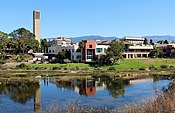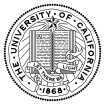
Goleta is a city in southern Santa Barbara County, California, United States. It was incorporated as a city in 2002, after a long period as the largest unincorporated populated area in the county. As of the 2000 census, the census-designated place (CDP) had a total population of 55,204. A significant portion of the census territory of 2000 did not include the newer portions of the city. The population of Goleta was 32,690 at the 2020 census. It is known for being close to the University of California, Santa Barbara (UCSB), campus.

Isla Vista is an unincorporated community in Santa Barbara County, California, in the United States. As of 2020 census, the community had a population of 15,500. For statistical purposes, the United States Census Bureau has defined the community as a census-designated place (CDP). The majority of residents are college students at the University of California, Santa Barbara, or Santa Barbara City College. The beachside community of Isla Vista lies on a flat plateau about 30 feet (9 m) in elevation, separated from the beach by a bluff.
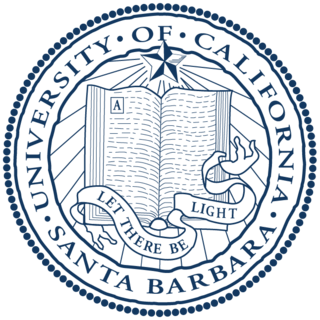
The University of California, Santa Barbara is a public land-grant research university in Santa Barbara County, California, United States. Tracing its roots back to 1891 as an independent teachers' college, UCSB joined the University of California system in 1944. It is the third-oldest undergraduate campus in the system, after UC Berkeley and UCLA.

The College of Creative Studies (CCS) is the smallest of the three undergraduate colleges at the University of California, Santa Barbara, unique within the University of California system in terms of structure and philosophy. Its small size, student privileges, and grading system are designed to encourage self-motivated students with strong interests in a field to accomplish original work as undergraduates. A former student has called it a “graduate school for undergraduates”. The college has roughly 350 students in nine majors and approximately 60 professors and lecturers. There is an additional application process to the standard UC Santa Barbara admission for prospective CCS students, and CCS accepts applications for admissions throughout the year.

California State University Channel Islands is a public university in Ventura County, California. Located near the city of Camarillo, it opened in 2002 as the 23rd campus in the California State University system. CSUCI is located on the Central Coast of California, at the intersection of the Oxnard Plain and northernmost edge of the Santa Monica Mountains range. The Channel Islands are nearby where the university operates a scientific research station on Santa Rosa Island.

Thomas More Storke was an American journalist, politician, postmaster, and publisher. He won the Pulitzer Prize in 1962. Storke also served as an interim United States Senator, appointed to serve between the resignation of William Gibbs McAdoo in November 1938 and the January 1939 swearing-in of Sheridan Downey, who had been elected to succeed McAdoo.

Merrill College is a residential college at the University of California, Santa Cruz. The theme of the college, and the name of its freshman core course, is "cultural identities and global consciousness."
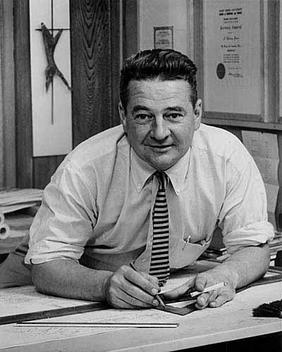
Archibald Quincy Jones was a Los Angeles–based architect and educator known for innovative buildings in the modernist style and for urban planning that pioneered the use of greenbelts and green design.
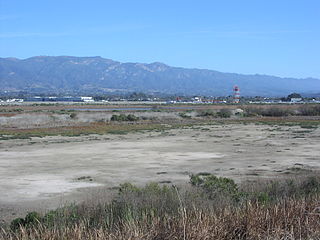
The Goleta Slough is an area of estuary, tidal creeks, tidal marsh, and wetlands near Goleta, California, United States. It primarily consists of the filled and unfilled remnants of the historic inner Goleta Bay about 8 miles (13 km) west of Santa Barbara. The slough empties into the Pacific Ocean through an intermittently closed mouth at Goleta Beach County Park just east of the UCSB campus and Isla Vista. The slough drains the Goleta Valley and watershed, and receives the water of all of the major creeks in the Goleta area including the southern face of the Santa Ynez Mountains.
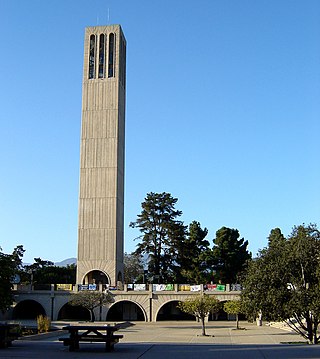
Storke Tower is a landmark campanile located on the campus of the University of California, Santa Barbara in the United States. Dedicated for use on September 28, 1969, the 61-bell carillon tower stands 175 ft (53 m) tall. It was designed by the San Francisco architecture firm Clark and Morgan.
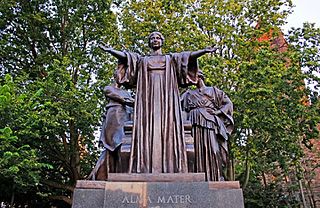
The University of Illinois Urbana-Champaign is an academic research institution that is the flagship campus of the University of Illinois System. Since its founding in 1867, it has resided and expanded between the twin cities of Champaign and Urbana in the State of Illinois. Some portions are in Urbana Township.

The University of California, Santa Barbara Library is the university library system of the University of California, Santa Barbara in Santa Barbara, California. The library includes four facilities: two libraries and two annexes. The library has some three million print volumes, 30,000 electronic journals, 34,450 e-books, 900,055 digitized items, five million cartographic items, more than 3.7 million pieces of microform, 167,500 sound recordings, and 4,100 manuscripts. The library states that it holds 3.2 miles (5.1 km) of manuscript and archival collections.

The Coastal Science Campus of the University of California, Santa Cruz consists of five main institutions: UC Santa Cruz's Long Marine Laboratory, UC Santa Cruz's Coastal Biology Building, the NOAA Southwest Fisheries Science Center, the Seymour Marine Discovery Center, and the California Marine Wildlife Veterinary Care and Research Center.
The main campus of the University of California, Riverside (UCR) is located within the city of Riverside in western Riverside County, three miles (5 km) east of downtown, and comprises 1,112 acres (4.50 km2) bisected by the Interstate 215/State Route 60 freeway. Nearly half of the total area is devoted to agricultural teaching and research fields, most of which are located west of the freeway.

The Cheadle Center for Biodiversity and Ecological Restoration (CCBER) is a research center under the Office of Research at the University of California, Santa Barbara (UCSB) whose mission is to preserve regional biodiversity and restore ecosystems on campus lands. CCBER has three main functions: curation and preservation of natural history collections, native coastal ecosystem and habitat restoration on campus lands, and education and outreach for both UCSB students and local community schools.

Goleta Point is a small peninsula at the southern end of the Gaviota Coast on the central coast in the U.S. state of California. It is located 3 miles (4.8 km) southwest of the city of Goleta. Situated within the campus of University of California, Santa Barbara (UCSB), it is characterized by a beach cliff, crashing waves, and a view of the Channel Islands across the Santa Barbara Channel. The rock formation is frequented by shorebirds.

Central Campus is the primary academic and administrative section of Cornell University's main campus in Ithaca, New York. It is bounded by Libe Slope to its west, Fall Creek to its north, and Cascadilla Creek to its south.
Esherick Homsey Dodge and Davis is a United States-based architecture, interiors, planning and urban design firm. EHDD is ranked among the top 20 architecture firms in the San Francisco Bay Area where it is headquartered, and is recognized for collaboration, commitment to innovation and investigation, and responsiveness to location, light, and climate.
The University of California, Santa Barbara (UCSB) traces its roots back to the 19th century, when it emerged from the Santa Barbara School District, which was formed in 1866 and celebrated its 145th anniversary in 2011. UCSB's earliest predecessor was the Anna S. C. Blake Manual Training School, named after Anna S. C. Blake, a sloyd-school which was established in 1891. From there, the school underwent several transformations, most notably its takeover by the University of California system in 1944.

University Hall is the main academic building at the Ohio State University in Columbus, Ohio. The building houses classrooms for several of the university's colleges and includes a museum on the ground floor.






















